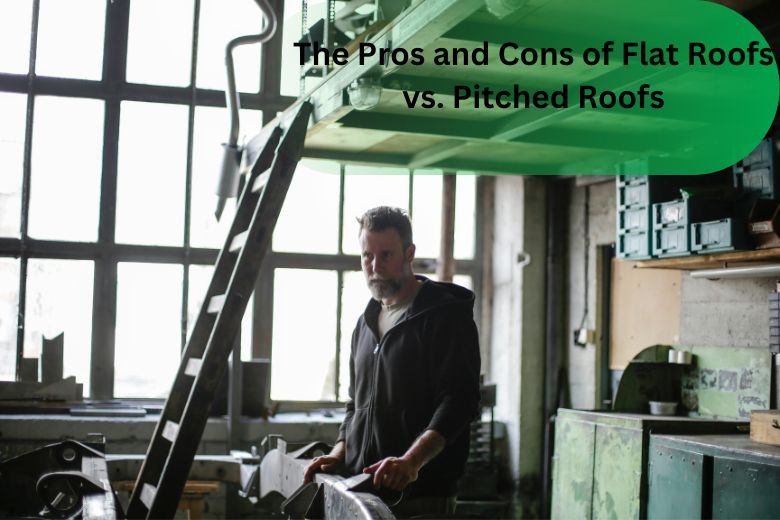The Pros and Cons of Flat Roofs vs. Pitched Roofs
Posted on August 03, 2024 by Admin

Among the most critical choices made by an individual in terms of a house or any other kind of building concerns the kind of roofing to install. This affects both the appeal and functionality of the building. For example, both flat roofs and pitched roofs have their pros and cons. The following is a detailed comparison of the two major roofing types.
Flat Roofs vs Pitched Roofs: Pros and Cons
Flat Roofs
Pros of Flat Roofs
- Cost-Effective: Flat roofs require less material or even lesser labor to be fixed, hence becoming more pocket-friendly compared to pitched roofs.
- Easy Access: The flat surface allows easy access to the performance of maintenance, repairs, or even inspections. Moreover, in terms of installing HVAC units, solar panels, or even creating a rooftop garden, one will find this really convenient.
- Modern Aesthetic: Flat roofs have a sleek, modern appeal; apart from the additional advantage of added usable space that can be used for leisure activities.
Cons of Flat Roofs
- Poor Drainage: On the downside, the major drawbacks for a flat roof are the poor drainage. Water is collected on the surface and can lead to leakage and cause structural damage if not monitored properly over time.
- Short Life Expectancy: Flat roofs usually have a shorter life expectancy compared to pitched roofs. They tend to wear out more due to climatic change, particularly in an area with heavy rainfall or a large amount of snowfall.
- Problematic Flat Roof Insulation: It can be really time-consuming to insulate flat roofs efficiently, and this can increase heating and cooling costs.
Must Read : Top 5 Signs Your Roof Needs Repair or Replacement
Pitched Roofs
Pros of Pitched Roofs
- Better Drainage: The sloping design makes pitched roofs very effective at water run-off and reduces problems caused by leakages or water damage, thus proving to be quite useful in areas of heavy rainfall or snowing.
- Longevity: In general, pitched roofs have a long life because of their solid construction and efficient drainage system. They can last for many decades if properly maintained.
- Energy Efficiency: Pitched roofs offer superior insulation and ventilation choices for giving constant indoor temperatures and saving energy costs.
Cons of Pitched Roofs
- More Expensive: A pitched roof requires more materials and labor to build; thus, installation costs more than for flat roofs.
- Complex Maintenance: pitched roofs are difficult to access; thus, maintenance, repair work, and even inspections are rather complicated and pricey.
- Design Limitations: pitched roofs definitely do not work with all architectural styles. They also encroach on usable space on the roof—a disadvantage for those who need to use their rooftop.
Must Read : The Benefits of Regular Roof Maintenance
Conclusion
Considering everything, one could contrast flat roofs vs. pitched roofs by cost, appearance, climate, and personal needs of the building. There exist specific advantages and disadvantages for both styles. Weighing the pros and cons of flat roofs versus pitched roofs will guide you in selecting the best option for your needs and improve your property value.
Faqs
-
1. What is more energy-efficient between the two: a flat roof or pitched roof?
Accordingly, pitched roofs are relatively more energy-efficient due to the better possibilities of insulation and ventilation. They create an interior climate that is stable and decreases the need for excessive heating or cooling. However, flat roofs can also be energy efficient when suitable insulation is provided and green roofing elements, such as rooftop gardens, are added.
-
2. Can flat roofs be used everywhere?
Flat roofs are most suitable for dry areas with very minimal rainfalls. If you live in an area prone to heavy rainfalls or snowfalls, this roof may bring along a lot of drainage issues and requires additional upkeep. This is greatly offset by proper waterproofing and drainage systems, but pitched roofs are generally more favored where the climate is wet.
-
3. How often are flat roofs replaced?
In most cases, flat roofs can serve for 10-20 years depending on the materials used and the quality of installation. Their life will increase with timely repairs and regular maintenance. On the other hand, pitched roofs can stay in service for 20-50 years or more, thus making them a more long-lasting option for so many house owners.
Recent Post
- Top Plumbing Service Providers in Arizona, USA
- Top 10 Electrician Service Providers in Alabama, USA
- Top 20 Roof Repair Service Providers in Alabama, USA
- The Role of Roof Insulation in Energy Efficiency: Tips and Tricks
- Understanding Roof Damage from Wildlife and How to Prevent It
- How to Choose the Best Roofing Contractor for Emergency Repairs
- Roofing Maintenance for Historic Homes: Preserving Architectural Integrity
- The Importance of Proper Attic Ventilation for Roof Health
- How to Identify and Prevent Roof Mold and Mildew
- The Best Practices for Removing Snow from Your Roof